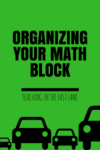Organizing your math block can feel like an uphill battle, but it doesn’t have to. By implementing the essential 5 elements in each and every math block you will be more organized and ready to tackle your next classroom challenge!

Do 5 essential elements sound too simple? They’re not, I promise. The truth is when you break down your math block into these 5 parts you are segmenting it into manageable tasks that are easier to plan for. Instead of planning a 90-120 minute period you are instead planning 5 smaller blocks. This is a good thing.
What Are the 5 Elements for Organizing Your Math Block?
When I think about a math block I break it down into a warm-up, a mini-lesson, student practice, stations and small group work, and a closure in the form of an exit ticket. These 5 elements allow me to take control of the amount of time spent on each element and make the most of my planning as well as stay student-centered.
I like to use a burger analogy, as do many others, to think about how I am organizing my math block. I will refer to this burger analogy throughout.
The Warm-Up
This is where the math block begins. It is the bottom burger bun, and we will build from here. A warm-up should take no more than 5-7 minutes for students to complete and for you to check together.
There are two different types of warm-ups I have used with my class. I have used warm-ups based on the content we are currently studying, and I have also used spiral warm-ups that cover a variety of content from throughout our standards for the year. I personally prefer the latter as it keeps learning fresh, but you choose what it best for your students.
No matter what type of warm-up you choose I strongly advocate for checking students’ work together each and every time.
For a spiral review style warm-up check out these Weekly Math Review resources.
The Mini-Lesson
I like to refer to the mini-lesson as the micro-lesson. The goal is to get in there, say what you need to say, and get out. This is the lettuce and tomato of your burger.
This whole group time is precious, but should not be allowed to get out of control. You want to minimize the time, you as the teacher, are the sage on the stage in order to capitalize on more student-centered learning time.
Your micro-lesson goal is less than 10 minutes. Ideally around 5 minutes.
I have to set a timer for myself to achieve this and wrap up where I am at, because otherwise before I knew it the whole math block would be over.
Student Practice

After your micro-lesson students need some time to practice the math skill they are learning about with your guidance. This section of your math block is the condiments on your burger.
Now is the time to pull out your cooperative learning strategies and have students work together to iron out any kinks you see. Students can scaffold the learning for one another and you can check in to see if anyone is struggling.
This section of your math block shouldn’t be longer than 10-15 minutes at most.
Small Group Work and Stations
This is the meat, or veggie patty if you will of your math block. This is where you should spend every last minute of your math block that you still have available.
Most students will be working with partners or threesomes in stations while you work with a small group. This time is sacred and should be treated as such. I usually spent about 45 minutes to an hour on this section of our math block rotating students as necessary.
I prefer to have math stations all based on our current standards, so I used these stations set up with ten stations for each standard. My students loved them, and I knew they were practicing towards mastery.
In my small group, we used these same stations for more guided practice along with whiteboards. When I noticed students struggling with a skill we would set aside the station and do some whiteboard practice until students were ready to move forward.
Closure with an Exit Ticket
To close out the math block, or put the top part of the bun on we would come back together as a group and complete an exit ticket. This section of the math block takes less than 5 minutes.
I prefer to use exit tickets that serve as a bridge to a “test like” question. This is the only time during the math block that I use multiple choice questions if I can help it. This allows students to see what a question will look like on the test without drowning them in test practice. It is the best of both worlds
For more information on how I used exit tickets check out this post.
Tools for Organizing Your Math Block
Are you ready to rock an organized math block but still find all the parts a bit daunting to plan? Check out these complete math units with lesson plans that include each of the 5 elements of the math block for every day of the unit.
FREE Math Unit!

Subscribe to get our weekly newsletter and your FREE Adding and Subtracting Fractions Unit!
